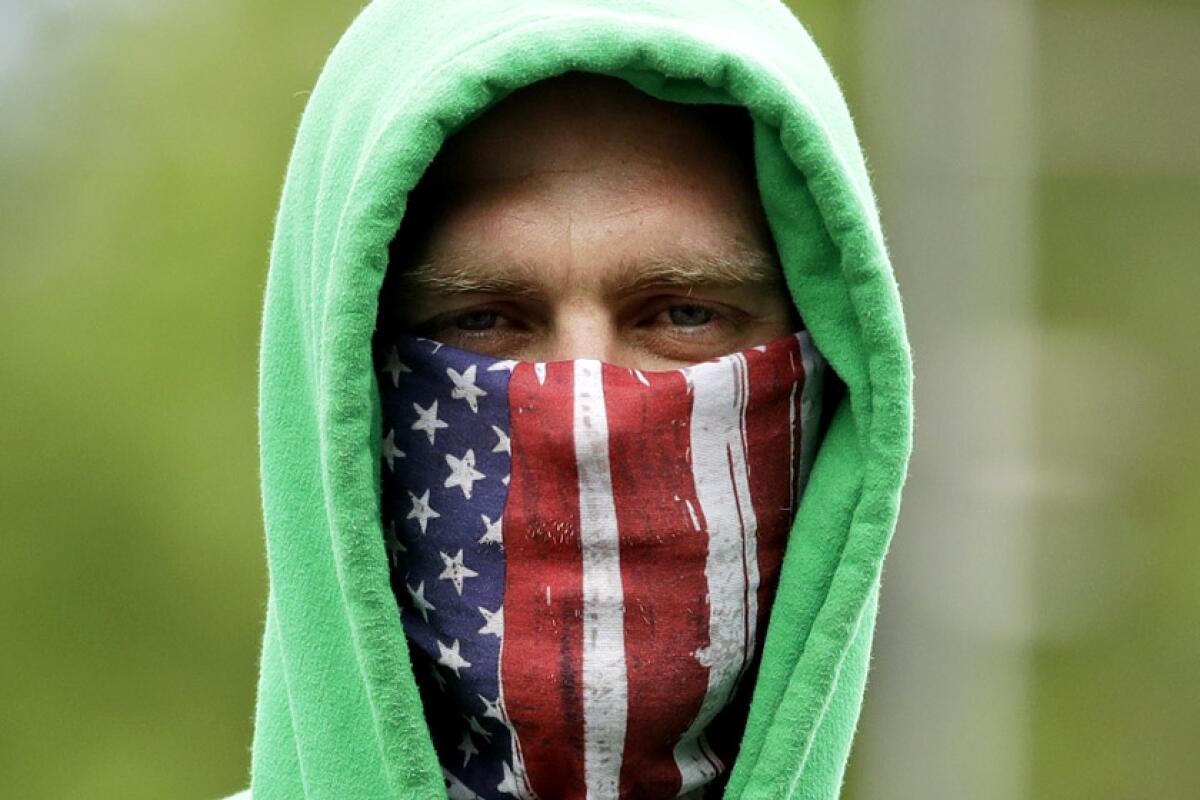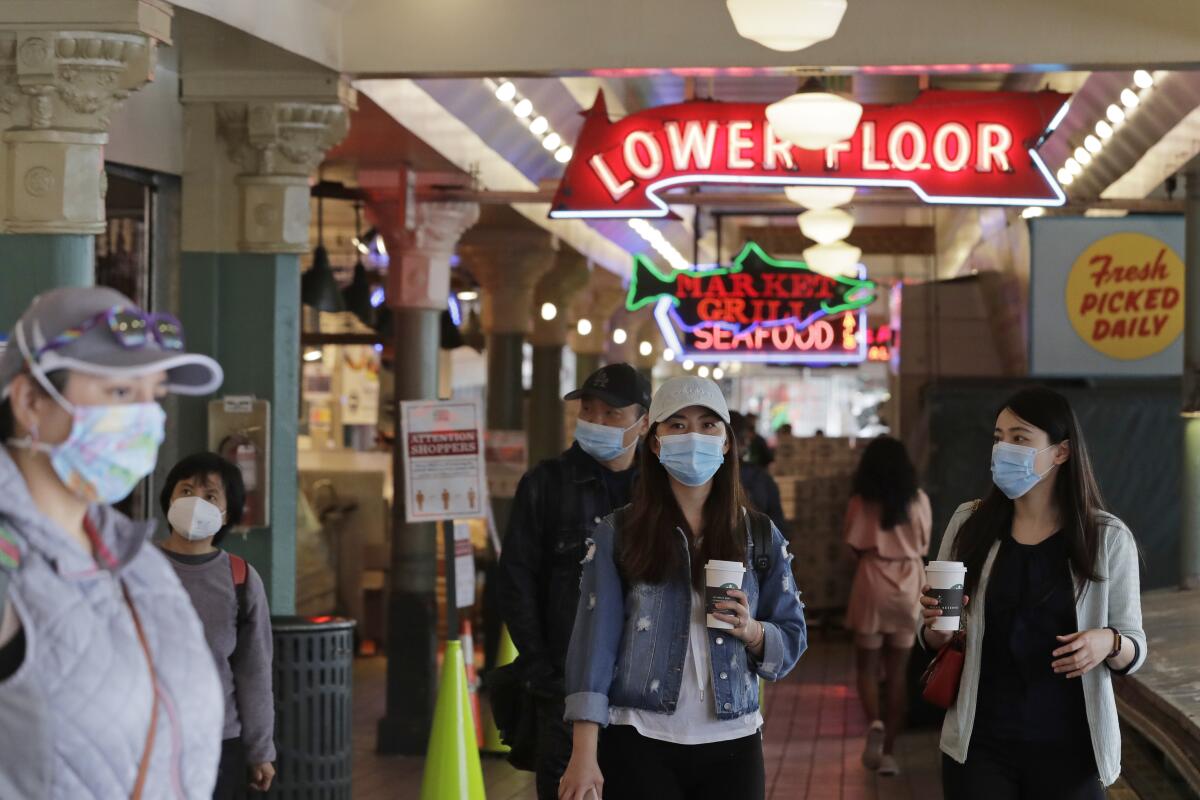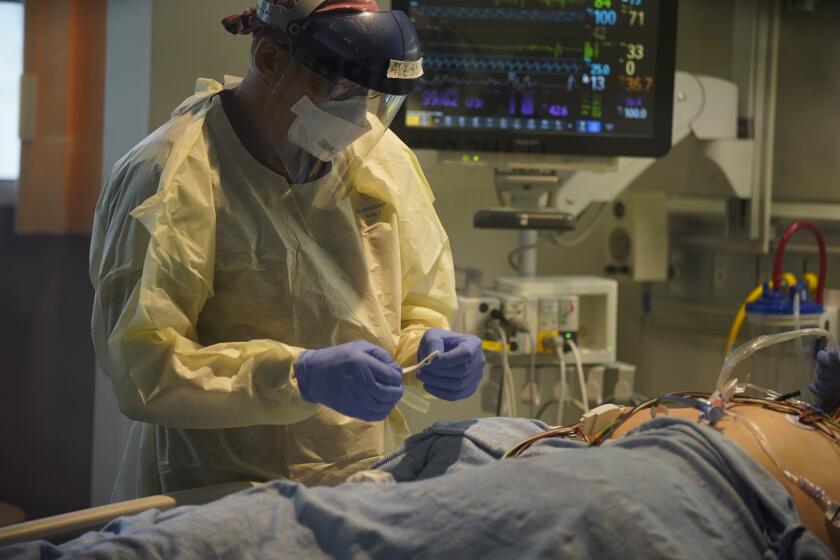New forecasts show why masks are the easiest — and cheapest — way to save U.S. lives

- Share via
If Americans would stop complaining about face masks and wear them when they leave their homes, they could save well over 100,000 lives — and perhaps more than half a million — through the end of February, according to a study published Friday in Nature Medicine.
The researchers considered five scenarios for how the COVID-19 pandemic could play out with different levels of mask-wearing and rules about staying home and social distancing. All the scenarios assumed that no vaccine was available, nor any medicines capable of curing the disease.
Consistently, the most effective — not to mention cheapest and easiest — way to reduce deaths was to increase the number of people wearing masks.
As of Sept. 21, only 49% of Americans said they “always” wore a mask in public, according to the study. If U.S. residents do not mask up in increasing numbers, they risk another round of mandatory social distancing measures that could shut businesses and schools around the country, the authors said.
“The potential life-saving benefit of increasing mask use in the coming fall and winter cannot be overstated,” wrote the team from the Institute for Health Metrics and Evaluation at the University of Washington.
The U.S. has experienced about 300,000 ‘excess deaths’ since the coronavirus came to America, and two-thirds of them can be attributed to COVID-19, the CDC says.
The forecasts also suggest that if states continue to ease their social distancing mandates and other restrictions despite the recent rise in COVID-19 cases, there could be more than 1 million deaths in the U.S. by the end of February.
And there is one additional key finding, said study leader Christopher Murray, the director of the institute.
Be forewarned — it’s not good news.
No matter what interventions states put in place, the analysis suggests we are heading into a very substantial fall and winter surge in coronavirus cases.
“The idea that the pandemic is going away we do not believe is true,” Murray said.
The researchers considered a wide range of variables to model how the pandemic would spread in different states, including past transmission patterns, the amount of testing per capita, how much people in the state move around, and how likely they are to wear masks. They also factored in things such as population density, how many smokers live in the state, and even altitude.
As with any modeling study, the five scenarios presented below should be considered a guide, rather than a definitive road map, the researchers emphasized.
“We are not forecasting the future, but rather a range of outcomes we believe are most probable given the scenarios tested and based on the data so far, ” they wrote.
Scenario 1: States continue to remove social distancing measures
AKA: The Do-Nothing Scenario
This is the worst-case scenario among the five the researchers considered. According to their models, this would result in a total of 1,053,206 Americans losing their lives to COVID-19 by Feb. 28 and more than 152 million infections across the country.
That death toll would not be felt equally everywhere, the researchers found. Instead, approximately one-third of the projected losses would occur in just three states. California would be hit hardest, with an estimated 146,501 deaths between Sept. 22 and Feb. 28. Florida would be next, with 66,493 deaths during that period, and Pennsylvania could expect 62,352 deaths.
The team also determined that if the U.S. follows this path, by election day, five states would experience a COVID-19 mortality rate of at least eight deaths per 1 million each day. (That’s about how bad things were when most states shut down their economies and issued stay-at-home orders in the spring.) An additional 35 states would exceed that threshold by Feb. 28.
Scenario 2: States shut down again after reaching eight deaths per 1 million people per day
AKA: The Bare Minimum Scenario
This response is a significant improvement on the scenario presented above.
If states shut down social interactions and economic activity at this threshold, the result would be an estimated 511,468 COVID-19 deaths by Feb. 28, the researchers found. That’s 541,738 fewer deaths than if states continue to remove social distancing measures indiscriminately.
Putting restrictions back in place would also reduce infections by nearly 81 million nationwide, according to the forecast. The state with the highest infection rate would be Arizona (46.2%), followed by New Jersey (41.1%) and Louisiana (33.3%).
The researchers consider this the most plausible scenario since this is how states reacted just a few months ago.
“We assume that states are going to reimpose mandates when things get quite bad because they are going to try to avoid hospital systems being overwhelmed,” Murray said.
Scenario 3: Universal mask use in public + states shut down after reaching eight daily deaths per million
AKA: The Ideal Scenario
If you start with the situation in Scenario 2 and improve it by having 95% of the people in each state wear masks outside their homes instead of the current 49%, the estimated COVID-19 total death toll would reach 381,798 by Feb. 28.
That’s 671,408 fewer deaths than if we keep doing exactly what we’re doing (or not doing) now. It’s also 129,670 fewer deaths than the shutdown scenario without universal mask use.
In addition, if everyone wore masks, only nine states — California, Colorado, Massachusetts, New Jersey, New Mexico, North Carolina, North Dakota, Pennsylvania and Rhode Island — would see their daily death rate rise high enough for more restrictive social distancing and shutdown measures to kick in, according to the model. The rest would be spared.
This strategy would also result in about 17.4 million fewer infections than if states reinstate social distancing and shutdown measures but don’t improve mask use.
However, that this is the best of the five scenarios should be sobering. The United States has already lost more than 220,000 lives to COVID-19. An additional 160,000 deaths over the next four months feels like way too many.

Scenario 4: 85% mask use in public + states shut down after reaching eight daily deaths per million
AKA: The Still-Pretty-Good Scenario
Mask wearing has become deeply politicized since the start of the pandemic, and it may feel unrealistic to expect 95% of Americans to cover their noses and mouths whenever they are in public. (Although it is worth noting that the people of Singapore were able to achieve this feat, as were residents of certain neighborhoods in New York City.)
To that end, the authors ran another scenario through their computer models. This one was very similar to the scenario described above, except that instead of 95% of the population wearing masks outside the home, just 85% did.
In this case, the researchers found that there would be 415,654 COVID-19 deaths through the end of February. That’s still about 96,000 fewer deaths than in Scenario 2, but 33,856 more deaths than in Scenario 3.
The authors said they were not surprised to learn that having even 85% of the population wear masks would make such a difference, but added that the modeling “does help to confirm that any additional coverage that can be achieved through mask use will save lives.”
Scenario 5: Universal mask use, social distancing measures removed
AKA: The “If Nothing Else, Mask Up” Scenario
Even if states do nothing in the face of rising COVID-19 case counts, nearly 563,000 American lives could be saved by increasing the percentage of people wearing masks in public from 49% to 95%, according to the model.
That’s also nearly 21,000 more lives saved compared to states shutting down again at the eight-daily-deaths-per-million threshold but not implementing rules on wearing masks.
These figures underscore the potential upside of wearing masks, the authors said.
“It is likely that U.S. residents will need to choose between higher levels of mask use or risk the frequent redeployment of more stringent and economically damaging SDMs,” or social distancing measures, they wrote. If neither of those options is appealing, they added, the alternative is to “face a reality of a rising death toll.”








